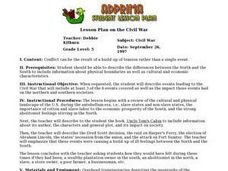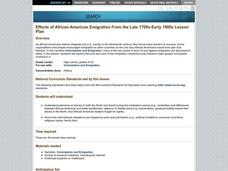National Endowment for the Humanities
Frances Ellen Watkins Harper’s “Learning to Read”
Frances Ellen Watkins Harper's poem "Learning to Read" is the focus of a lesson plan that teaches middle schoolers how to do a close reading of a text. The lesson plan introduces them to a brief biography of the poet, includes a video...
Curated OER
The Colonization of Liberia
Students analyze how slavery shaped social and economic life in the South. They study methods of passive and active resistance to slavery, and the similarities and differences between African-American and white abolitionists.
University of Richmond
Canals 1820-1860
While canals are not a common mode of transportation today, they were part of the fuel for America's industrialization. However, most of them were located in the North, also feeding regional differences and sectionalism. Using an...
Curated OER
When Rice Was King
Students examine the origins of rice production in the South. They identify the steps involved in rice cultivation, examine photos of plantation life, conduct interviews, and research the economic base of their own community.
University of Richmond
The Forced Migration of Enslaved People 1810-1860
Slavery not only involved the forced migration of African people from their homes, it also meant the forced removal of people within the United States. Using data and interactive graphics, scholars see how the tragedy of human slavery...
Curated OER
Uncle Tom's Cabin & The Ideology of Slavery
Students use "Uncle Tom's Cabin & American Culture" to examine the sectional crisis of the 1850's. Slavery is explored and the mindset of Southern planters during the Antebellum Era. They analyze not only traditional text documents...
Curated OER
Examining Slave Auction Documents
Students compare the social and cultural characteristics of the North, the South, and the West during the antebellum period, including the lives of African Americans and social reform movements such as abolition and women’s rights.
Curated OER
Aiken-Rhett House
Third graders visit the Rhett-Aiken House and discuss the people who lived there. They compare and contrast the lives of slaves who lived there. They practice using new vocabulary and examine the Gullah language and culture.
Curated OER
Free Market Labor vs. Slave Labor
Young scholars summarize support for free market labor vs. slave labor in antebellum America. They explain how existing economic conditions influence support for free market labor vs. slave labor.
Curated OER
The Glass Menagerie by Tennessee Williams
Provided here is a packet of worksheets to accompany The Glass Menagerie by Tennessee Williams. To start, readers research words commonly associated with the time period. Then, a list of 30 tough vocabulary words are listed (including...
Curated OER
Lesson 9: After Slavery: Uncle Tom's Cabin in Popular Culture
Eighth graders, in groups, explore the popularity of Uncle Tom's Cabin, even in the post-slavery America.
Curated OER
Slavery, Manumission, and Freedom: Free Blacks in Charleston before the Civil War
Students explore the concept of slavery and manumission through a variety of activities. In this civil rights lesson, students gather information from primary sources, then analyze the politics and historical context of the time....
Curated OER
U.S. History Worksheet #75
Get the facts straight when it comes to the Reconstruction Era! For this United States history worksheet, learners utilize a word bank of 10 terms or phrases to answer 10 fill in the blank questions about the nation following the Civil...
Curated OER
The Cotton Gin
High schoolers are introduced to an early American inventor, Eli Whitney, and his experiences with the Patent Office. The economic importance of the cotton gin and its impact on slavery are also addressed.
Curated OER
Primary Source Adventures: Runaway Slaves Lesson Plan
Fourth graders examine social changes in Texas during last half of ninteenth century relating to the institution of slavery. They brainstorm methods that unhappy slaves may have used to avoid obeying their masters, and read and discuss...
Curated OER
Utilitarianism
In this online interactive history worksheet, students respond to 9 short answer and essay questions about John Stuart Mill's Utilitarianism. Students may check some of their answers on the interactive worksheet.
Curated OER
Discovering the Past/Considering the Future: Lessons from the Eastern Shore
Young scholars study how the Freedmen's Bureau improved the living conditions among blacks on Maryland's Eastern Shore. They examine Social, Political, and Economic improvements and answer questions.
Curated OER
Retain or Abandon, Adapt or Convert? The Immigrant's Dilemma
Young scholars read and discuss a narrative exploring how immigrants retain their own cultures or assimilate into the host country. They examine the emigrant's experience in Liberia and write a position paper.
Curated OER
Lesson Plan on the Civil War
Fifth graders identify events leading to the Civil War and explain the impact the events had on northern and southern societies.
Curated OER
Mastering the Document-Based Essay Question
Students use a primary source document from the Civil War period of history in order to derive meaning for an essay question. The essay is based completely on the document with no other research to support the content.
Curated OER
Free Market Labor vs. Slave Labor Debating the "Mud-Sill" Theory
Students read the speeches of Abraham Lincoln and James Hammond. They discuss the speeches and answer questions about free labor vs. slave labor.
Curated OER
Piecing Character Traits Together from our History Using Technology
Students research basic biographical facts, contributions made to the state and country, and important historical events of both the state and country made during the lifetime of a famous North Carolinian.
Curated OER
Effects of African-American Emigration From the Late 1700s-Early 1900s
Students explore the pros and cons of the emigration movement and research major groups and people involved in it. They view a multi-media narrative imbedded in this plan, then compose an essay stating their point of view.
Curated OER
African Americans: 1800 - 1870
Students explore living and working environment of both slave and free African Americans from places throughout the United States.
Other popular searches
- Antebellum South Carolina
- Antebellum South Economy
- Antebellum South Carolinia
- Civil War Antebellum South
- Georgia, Antebellum South
- Georgia Antebellum South
- Antebellum South Unit
- The Antebellum South

























